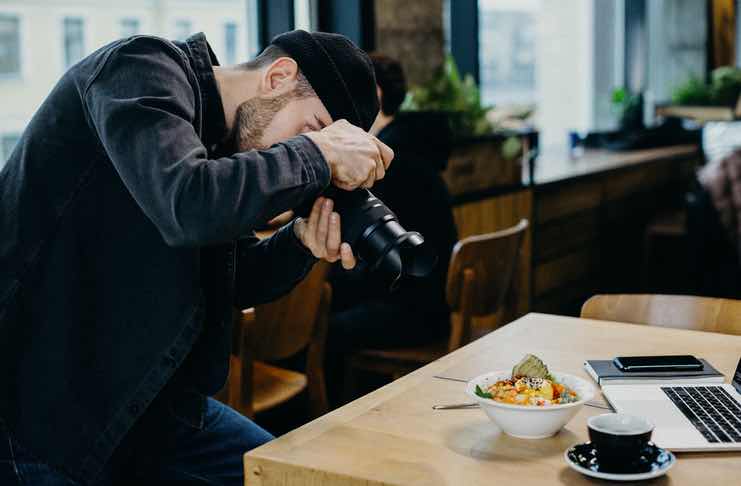Photography is a visual art, and the colors you use are critical for effect. It’s like painting with light – you’re not capturing the stark reality, but you interpret it. Colors can make or break your photos by adding something interesting to the composition or ruining it by seeming oversaturated and overdone.
We don’t even realize how significantly colors influence our minds, how they affect the way we perceive the world, and what we feel at the moment. There’s a whole science behind that!
So what about food? Doesn’t it speak for itself when it already looks delicious?
Well, no. Food photography can be tricky. According to Photography blog, ParkerPhotographic.com, with the wrong composition of colors, you can actually make your food look less appetizing, or at best uninteresting. To help you avoid it, especially if you’re only just starting your journey and taking some beginner photography courses, we have gathered a few tips on the best colors for food photography.
Consider the Colors of Your Food
While photographing, don’t think about what kinds of food you have, but only focus on the colors. Consider what is the dominant color of your food and should, therefore, be the dominant color of your photoshoot. Then, try to compose your photo from complementary and analogous colors.
Complementary colors contrast with each other in composition, while analogous colors are next to each other on the color wheel, belonging to the same family of colors.
Don’t Be Afraid of Contrasting Colors
Complementary, or contrasting colors very often are what makes a photo eye-catching. The bigger is the contrast, the bigger gets the perceived brightness, but without losing anything from the right color balance. Complementary colors are excellent at reinforcing each other, and they come in the following pairs: blue and yellow, red and cyan, green and magenta. So if, for example, you plan to photograph some lemons, it will be a great idea to arrange them with something blue.
Other contrasting pairs include yellow and red if you opt for a photo in warm colors, and green with blue if you prefer cooler tones.
It’s also recommended to experiment with the degrees of saturation. If you have ever been told to avoid mixing pastels with bright or deep colors, you can forget all about it.
Analogous Colors Calm the Composition
Sometimes, you may want a calmer, softer, well-toned effect, and it’s alright, too, as long as you don’t make it too bland. Analogous colors are in harmony with each other, and will, therefore, contribute to the more harmonious effect.
It’s a good idea if you don’t want anything to distract the attention from the subject of your photo, or if the theme for the photoshoot is about peace and pastels.
What About Monochromatic Composition?
The monochromatic composition consists mainly of the dominant color and its different shades. The effect may be overwhelming or bland if you’re not careful; however, if you do it right, you will achieve a harmonious, enjoyable composition.
Only black, white, and grey are achromatic, as they are natural parts of the greyscale. Each can be a great addition to monochromatic photography, but only if you choose the one with the least contrast. For example, if you compose your monochromatic photo around brown color, it’s best to complement it with black tones, or darker in general, not whites or greys.
Be Careful With Brown
Brown is a tricky color, especially when it comes to naturally brownish foods, such as meat. It may not be a good idea to photograph meat in a monochromatic composition, as brown is a color that is often associated with mud and dirt, which is something to be avoided when it comes to foods.
In the case of meat, it’s a better idea to enhance it by combining it with some neutral pastels or really bright and lively colors.
The same applies to green; it can be a great contrasting color if it’s bright, but beware of its darker tone, as it may end up looking rotten.
What About Foods with No Particular Color?
Some foods won’t stand out, whatever you do. Grains, potatoes, or pasta don’t have any distinguishable color, and it may seem impossible to take an interesting photo of them, especially if you prepare them without other colorful ingredients.
But remember – food photography is mainly about food but not only. There’s also garnish, crockery, tables, and other items that are always present during the meals. Your famous Macaroni and cheese may not look appealing on its own, but it will if you serve it in a colorful plate, on a turquoise table, or a patterned tablecloth.
It may even be enough to add some green parsley on top of the food to make the whole composition attractive.
However, while it may work in some very particular cases, it’s best to avoid patterns on plates.
Be Bold and Experiment with Your Food Photography
Photography is all about trying, experimenting, and crossing the lines. You can read a lot of tips on arranging your set and choosing colors, but there are situations where the best effect is created randomly. Don’t be afraid to try whatever comes to your mind. The best thing is that, with photography, there aren’t many risks; you can keep trying how often you want and need.
